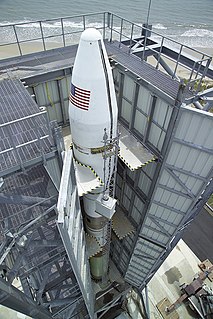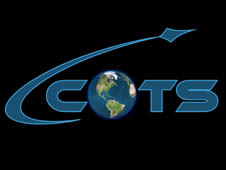Related Research Articles

Space Shuttle Discovery is one of the orbiters from NASA's Space Shuttle program and the third of five fully operational orbiters to be built. Its first mission, STS-41-D, flew from August 30 to September 5, 1984. Over 27 years of service it launched and landed 39 times, aggregating more spaceflights than any other spacecraft to date. The Space Shuttle launch vehicle has three main components: the Space Shuttle orbiter, a single-use central fuel tank, and two reusable solid rocket boosters. Nearly 25,000 heat-resistant tiles cover the orbiter to protect it from high temperatures on re-entry.

The planet Mars has been explored remotely by spacecraft. Probes sent from Earth, beginning in the late 20th century, have yielded a large increase in knowledge about the Martian system, focused primarily on understanding its geology and habitability potential. Engineering interplanetary journeys is complicated and the exploration of Mars has experienced a high failure rate, especially the early attempts. Roughly sixty percent of all spacecraft destined for Mars failed before completing their missions and some failed before their observations could begin. Some missions have met with unexpected success, such as the twin Mars Exploration Rovers, Spirit and Opportunity which operated for years beyond their specification.

Uncrewed spaceflights to the International Space Station (ISS) are made primarily to deliver cargo, however several Russian modules have also docked to the outpost following uncrewed launches. Resupply missions typically use the Russian Progress spacecraft, European Automated Transfer Vehicles, Japanese Kounotori vehicles, and the American Dragon and Cygnus spacecraft. The primary docking system for Progress spacecraft is the automated Kurs system, with the manual TORU system as a backup. ATVs also use Kurs, however they are not equipped with TORU. Progress and ATV can remain docked for up to six months. The other spacecraft — the Japanese HTV, the SpaceX Dragon and the Northrop Grumman Cygnus — rendezvous with the station before being grappled using Canadarm2 and berthed at the nadir port of the Harmony or Unity module for one to two months. Under CRS phase 2, Cargo Dragon will dock autonomously at IDA-2 or 3 as the case may be. As of November 2021, Progress spacecraft have flown most of the uncrewed missions to the ISS.

The Minotaur is a family of United States solid fuel launch vehicles derived from converted Minuteman and Peacekeeper intercontinental ballistic missiles (ICBM). They are built by Northrop Grumman via contract with the Air Force Space and Missile Systems Center's Space Development and Test Directorate (SMC/SD) as part of the Air Force's Rocket Systems Launch Program which converts retired Intercontinental Ballistic Missiles into space and test launch systems for U.S. government agencies.

Commercial Orbital Transportation Services (COTS) was a NASA program to coordinate the development of vehicles for the delivery of crew and cargo to the International Space Station by private companies. The program was announced on January 18, 2006 and successfully flew all cargo demonstration flights by September 2013, when the program ended.
This is a timeline of space exploration including notable achievements and first accomplishments or major events in humanity's exploration of outer space.

Karen LuJean Nyberg is an American mechanical engineer and retired NASA astronaut. Nyberg became the 50th woman in space on her first mission in 2008.

Space Launch Complex 40 (SLC-40), previously Launch Complex 40 (LC-40) is a launch pad for rockets located at the north end of Cape Canaveral Space Force Station, Florida.

This comparison of orbital launch systems lists the attributes of all individual rocket configurations designed to reach orbit. A first list contains rockets that are currently operational or in development; a second list includes all retired rockets. For the simple list of all conventional launcher families, see: Comparison of orbital launchers families. For the list of predominantly solid-fueled orbital launch systems, see: Comparison of solid-fueled orbital launch systems.

David Saint-Jacques is a Canadian astronaut with the Canadian Space Agency (CSA). He is also an astrophysicist, engineer, and a physician.

Mark Thomas Vande Hei is a retired United States Army officer and current NASA astronaut who has served as a flight Engineer for Expedition 53, 54, 64, and 65 on the International Space Station. He is married to Julie Vande Hei.
NASA has hosted many events for its social media enthusiasts called NASA Socials beginning in 2009. These events are targeted at the social media followers of NASA through platforms such as Twitter, Facebook, Google Plus, Instagram, YouTube and more. They provide guests with VIP access to NASA facilities and speakers with the goal of leveraging participants' social networks to further the outreach requirements of NASA as laid out in the National Aeronautics and Space Act. NASA re-branded these events as "Socials" in March 2012 as it expanded participation to services beyond just Twitter.

This article documents expected notable spaceflight events during the year 2022.

Dimorphos is a small asteroid satellite that was discovered in 2003. It is the minor-planet moon of a synchronous binary system with 65803 Didymos as the primary asteroid. After being provisionally designated as S/2003 (65803) 1 with informal nicknames such as "Didymos B" and "Didymoon", the Working Group Small Body Nomenclature (WGSBN) of the International Astronomical Union gave the satellite its official name on 23 June 2020. At a diameter of 170 metres (560 ft), it is one of the smallest astronomical objects that has been given a permanent name.

Expedition 66 is the 66th long-duration expedition to the International Space Station. The mission began after the departure of Soyuz MS-18 on 17 October 2021. It was commanded by European Space Agency astronaut Thomas Pesquet, the fourth European astronaut to command the ISS and first French astronaut to command the orbital laboratory, until 8 November 2021, when Russian cosmonaut Anton Shkaplerov, who arrived aboard Soyuz MS-19, took over his command.
USA-197, also known as DSP-23, is a missile detection satellite and part of the Defense Support Program that was launched in 2007.
References
- ↑ "NASA - NSSDCA - Spacecraft - Details". nssdc.gsfc.nasa.gov. Retrieved 2021-04-09.
- ↑ "Quasar 12, 13, 14, 15, 16, 17, 18, 19 (SDS-3 1, 2, 3, 4, 5, 6, 7, 8)". Gunter's Space Page. Retrieved 2021-04-09.